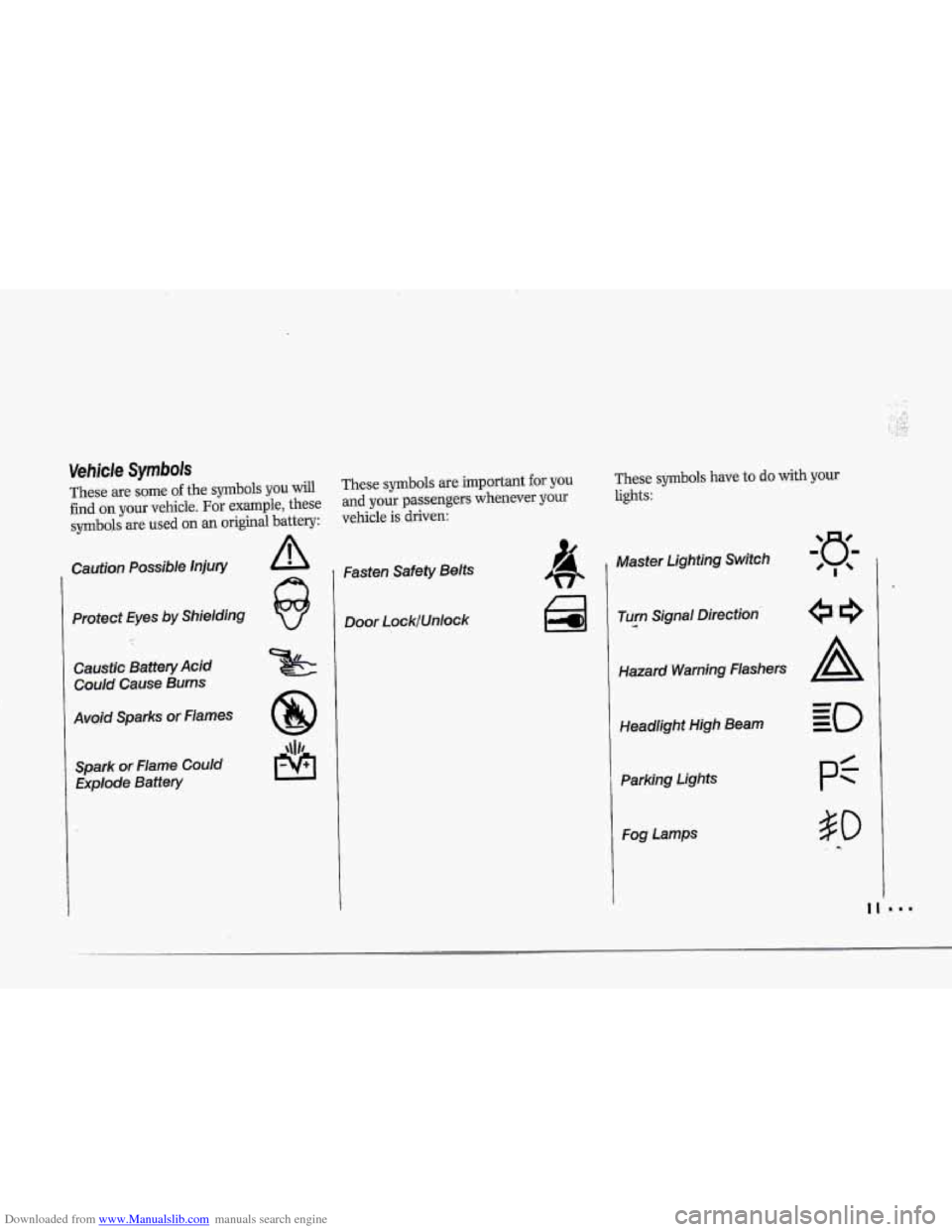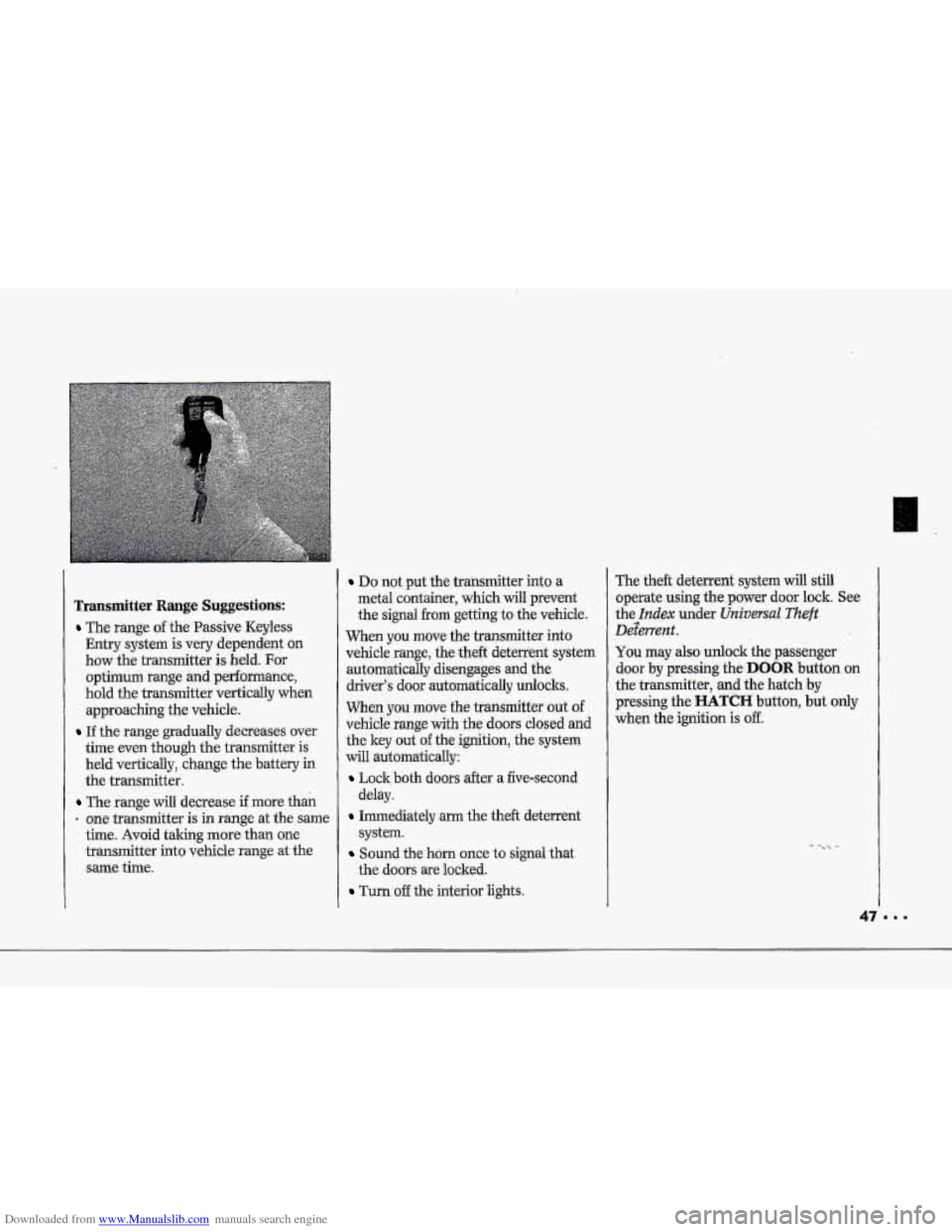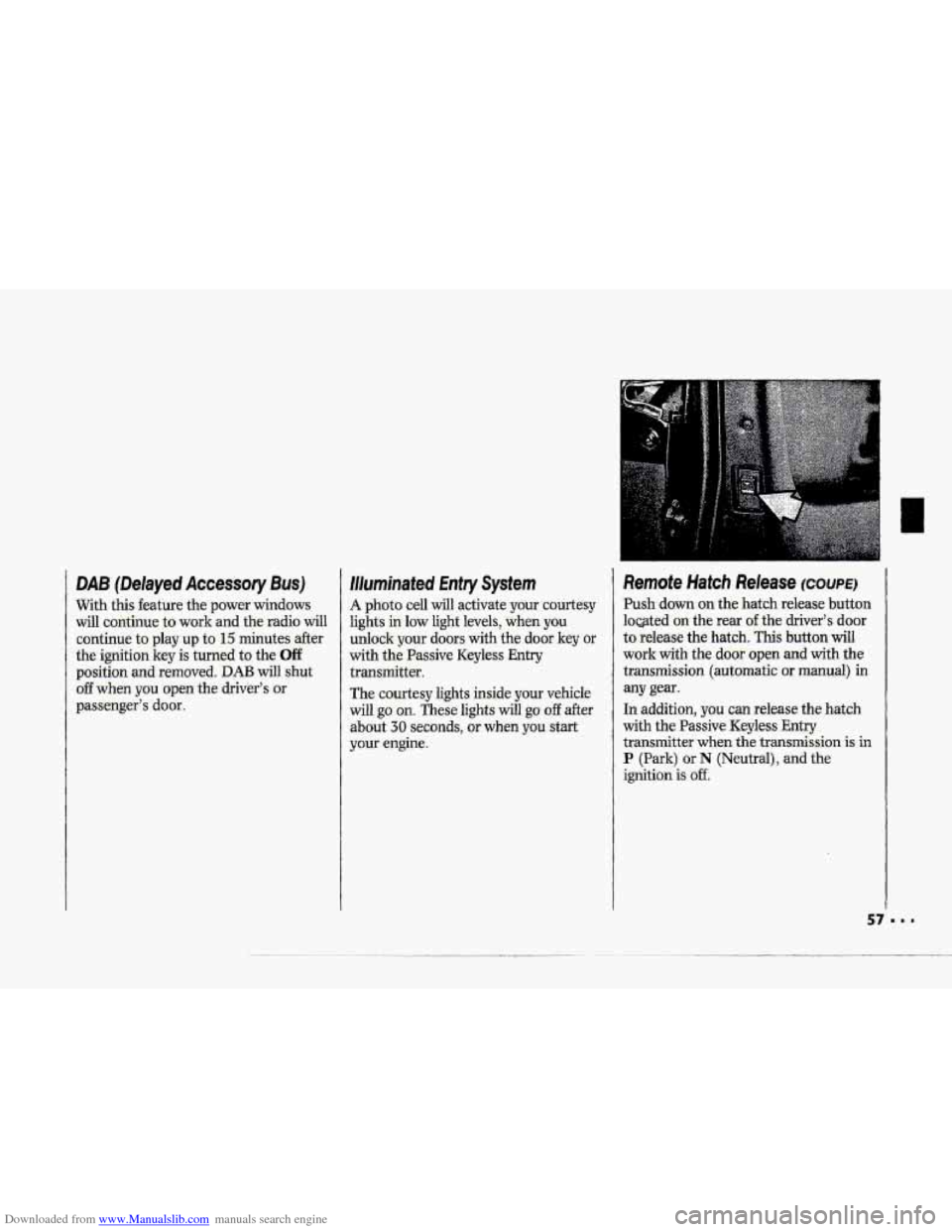1993 CHEVROLET CORVETTE lights
[x] Cancel search: lightsPage 12 of 370

Downloaded from www.Manualslib.com manuals search engine These are some of the symbols you will
find on your vehicle. For example, these
symboJs are used on an original battery:
Caution Possible injury
Protect Eyes by Shielding
Caustic Battery Acid
Could Cause Burns
Avoid Sparks or Flames Spark or Flame Could Explode Battery
These symbols are important for you These symbols have to do with yow
and your passengers whenever your lights:
vehicle is driven:
Fasten Safety Belts
Door LocklUnlock 1 Master Lighting Switch
Turn
.--a Signal Direction
Hazard Warning flashers
Headlight High
Beam
Parking Lights
Fog Lamps
Page 19 of 370

Downloaded from www.Manualslib.com manuals search engine -. -
Seats & Safety Belts
.. .
.. . , ., ..
let ahyone.--d& kh&ie’, .
. . .. , , , .. ..
. they -can’t wear a .sdcty
properly:
.If you care in a.crash and . .’
you!re not yearing a safety.belt.,
your iajuries can ,ibe..much worse.
You
can hit things,inside the
vehicle
or be ejected from it. You
can be seriously injured or killed. In
t’hesame crash, you might not be if
you are :buckled up. Always fasten
your
.safety belt, and check that
your -passenger’s.belt is fastened
properly t
oo.
18
This figure lights up when you turn the
key to Run or Start when your safety
belt isn’t buckled,
and you’ll hear a
chime,
too. It’s the reminder to buckle
up.
In many states and Canadian provinces,
the law says
to wearsafety belts. Here’s
why: They work.
You never lnow- if you’ll be in a crash.
If you do have a crash, you don’t know
if it will be a bad one.
A few crashes are very mild. In them,
you won’t get hurt even if you’re not
buckled up. And some crashes m be
so serious, 1ike.being-hit by a train, that
even buckled
up a person wouldn’t
survive.
But most crashes are in
between.
In many of them, people who
buckle-up can survive and someti-mes
walk
away. Without belts they could be
badly hurt or killed.
After 25 years of safety :belts in vehicles,
the facts are clear.
In most crashes
buckling up does matter ... a lot!
Page 42 of 370

Downloaded from www.Manualslib.com manuals search engine !
....
+-
Here you can learn about the
many standard and optional features
on your Corvette. and information on
starting. shifting and braking . Also
explained are the instrument panel
and the warning systems that tell you
if everything is working properly-
and what to do if you have a
problem .
Part 2
Features & Controls
Keys ........................................................................\
........................................... 42
Locks ........................................................................\
......................................... 43
Passive Keyless Entry System ........................................................................\
... 44
Glove Box ........................................................................\
.................................. 59
Starting Your Engine ........................................................................\
.................. 61
Engine Block Heater ........................................................................\
................. 66
Shifting the Transmission ........................................................................\
......... 67
Parlring Brake ............................................... .................................................... 77
Turn SignaVHeadlight Beam Lever .................................................................. 82
Windshield Wipers~asher ........................................................................\
....... 83
Cruise Control ........................................................................\
............................ 84
PASS-Key'" ........................................................................\
....................................... 55
Ignition ........................................................................\
...................................... 60
Windows ........................................................................\
..................................... 81.
Headlights ........................................................................\
.................................. 89
Interior Lights ........................................................................\
........................... 91
Storage Compartments ........................................................................\
............. 95
Mirrors 92
Sun Visors ........................................................................\
................................. 93
Ashtray and Lighter ........................................................................\
................... 96
Instrument Panel ........................................................................\
...................... 98
Warning Lights, Gages and Indicators ........................................................... 1 02
........................................................................\
.......................................
Trip Monitor ........................................................................\
............................. 1 IO
Driver Information Center ........................................................................\
. .:. .... 112
Convertible Hardtop ........................................................................\
................ 128
Removable Roof Panel ........................................................................\
............ 120
Convertible Top ........................................................................\
...................... 124
41
Page 47 of 370

Downloaded from www.Manualslib.com manuals search engine Transmitter Range
The Passive Keyless Entry system
sen-ses the transmitter when it is within
a certain-range of the vehicle. When the
transmitter
is' within this range, the
doar(s) will unIock auto-matieally (if the
passive feature
is enabled), the theft
deterrent system will
be disarmed, -and
the courtesy lights wilI be turned on (if
it is dark enough outside).
Transmitter
ranges., as shorn in the
coupe and convertibie illustrations, are
as follows:
Range
A: .5-7 feet (.11h-2 m)
Range B: 3-5 feet. (1-1% rn)
Features & Controls
.. . .. .. _I . . .- . ..
. ..
The signal of the transmitter is picked
up by two antennas. On the coupe, one
antenna is located in the driver's door
and one is
located in the rear of the
luggage-area. These antennas do not
require any routine maintenance I
Transmitter Range (Convertible)
Qn the convertible, one antenna is
located in the driver's
door and one- is
located
in the passenger's -door. These
antennas do not require any routine
maintenance.
F
Page 48 of 370

Downloaded from www.Manualslib.com manuals search engine i"" V'
r"
Transmitter Range Suggestions:
The range of the Passive Keyless
EMry system is very dependent on
bow
the transmitter is held. For
opthum range hd performance,
hold the transmitter
vertically when
approaching the vehicle.
If the range gradually decreases over
time even though the transiitter is
held
vertically, change the battery in
the transmitter.
The range will decrease if mure than
one3ransmitter is in range at the same
time.
Avoid taking more than one-
transmitter into vehicle range at the
same time.
Do not put the transmitter into a
metal container, which
will prevent
the
.signal from getting- to the vehicle.
hen you move the transmitter into
vehicle range, the
theft deterrent system
automatically disengages and the
driver's door automatically unlocks.
When you move the transmitter out of
vehide range with the' do.ors closed and
the
key out af the ignition, the system
will automatically:
Lock both .dooxs after -a five-second
Immediately arm the theft deterrent
Sound the horn once to signal that
Turn-off the interior lights.
delay.
system.
the doors are locked.
The theft deterrent system will still
operate using the .pma d0.w lock. See
the Index under .Universal The#?
DeZerrenzt.
You mEQT also Llnbclr the passenger
door by pressing the-DOOR-buttoil Qn
the transmitter, and the hatch by
pressing the HATCH button, but only
when the ignition is off.
Page 58 of 370

Downloaded from www.Manualslib.com manuals search engine DAB. (Delayed Accessory Bus)
With this feature the: power windows
will continue to work and the radio will
continue
to play .up,to 15 minutes after
the ignitiorikey is turned to the Off
position and: removed. DAB will shut
off when you open the ,driver’s or
passenger’sdoor.
illuminated Entry System
A photo cell will activate your :courtesy
lights in low light levels, when you
unlock your do-ors with the door key or
with the Pawive Keyless Entry
,transmitter.
The courtesy lights inside your vehicle
will
go on. These lights will go off after
about 30 seconds, or when you start
your engine.
Remote Hatch Release COUPE^
Push-down. on the hatch release button
loated
on the rear ofthe driver’s door,
to release the hatch. This button will
work with the dooi. open and with the
transmission (automatic
ar manual) in
any gear.
In addition, YQU can release the hatch
with the Passive Keyless
Entry
transmitter when the transmission is.. in
P (Park) or N (Neutral), and the
ignition
is off.
Page 61 of 370

Downloaded from www.Manualslib.com manuals search engine Features & Controls
Ignition Switch
With the-ignition key in the ignition
switch, you can turn
the switch to five
p.ositions:
Accessory: An “on” position in which
you
can operate your .electrical power
accessories. Press in the-ignition .switch
as
you turn the top of it toward you.
Lock: The only position in which you
can remove the key. This locks your
steering wheel, ignition. and automatic
shift lever.
UE Udo:cks the steering wheel,
ignition, and automatic shift lever. Use
this pasition if your vehicle must be
pushed or towed, but never try to push-
start your vehicle-.
A warning chime will
sound if you open the driver’s door when
the ignition is
off and the key is in
the ignition.
Run: An “on” position to which the
switch returns after you start your
engine and release the switch. The
switch stays in
the Run position when
the engine is running. But -even when
the engine is-not running, you can use.
Run to operate your electrical power
accessories,
and to display some instru-
ment panel warning lights.
Start: Starts the engine, When the
engine starts, release the key. The
ignition switch will return to
Ruil fot
noma1 driving.
Note
that even if the engine is not
running, the positions
Accessory and
Run are “on” positions that allow y0.u
to operate your electrical accessories,
such
as the radio.
Key Release Button
(MANUAL TRANSMISSION)
..With a manual transmission, the
ignition key c-ot be removed from
the ignition unless the key release
button is used.
To Remove the Key:
Turn the key to the Lock position while
pressing the
key release buttoa down at
the same time. Keeping your thumb on
the button, pull the key straight out.
Page 83 of 370

Downloaded from www.Manualslib.com manuals search engine ..a
Features & Controls
Turn Signal/Headlight Beam
Lever
The lever on the left side of the steering
column includes your:
. Turn Signal and Lane Change
4 Headlight 'High-Low Beam Changer
Windshield Wipers
Windshield Washer
Cruise Control
The High-Low Beam feature is
discussed under
HeadZights. See the
Index under Headlights.
Indicator
32
E
Turn Signal and fane Change
Indicator
The turn signal has two upward (for
Right) -and two downward (for
Left)
positions. These positions allow you to
signal a turn or a lane change.
TO signal a turn, move the lever all the
way up
01- down. When the.turn is
finished, the lever will return
automatically.
A green arrow on the instrument panel
will flash in the direction af the turn or
lane change.
To signal
a lane change, just raise or
lower the lever until the-green arrow
starts
to flash. Hold it there until you
complete your lane change. The lever
will return
by itself when you release it.
As you~ignal a turn or a lane change, if
the arrows don't flash but just stay on, a
signal bulb may be burned out and
other drivers
won't see your turn signa1.
If a bulb is burned out, replace it to help
avoid .an accident. If the green
arrows
don't-go on at all when you signal a
turn, check the fuse (see the Index
under Fuses G Circuit Breizkers) and
for burned-out bulbs.
A warning chime will remind you if you
have left your turnsignal cm for more
than 1 mile (1.6 km) 'of driving.